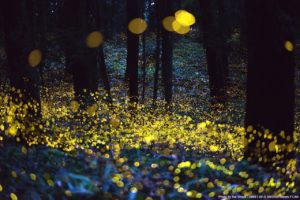Co-author: Mackenzie Scherr
Admit it, some of us are scared of the dark, especially when we are outside. Not to fear, there are three solutions to this problem: (a) go inside where there is light; (b) carry a flashlight; or (c) carry a jar of fireflies. Who knew that fireflies can actually be a good source of light and an effective way to reduce your carbon footprint! Despite their name, fireflies are actually beetles that shine a bright light for a duration of time (1). Their luminescence might catch our attention, but that is not enough to attract predators. In fact, some predators despise the taste of fireflies because they contain poison that is harmful to vertebrates (1). On the bright side, fireflies use light signals, or chemical signals, to attract mates (2). These signals enable the fireflies to distinguish between their own species and other fireflies. To date, there are over 2000 species of fireflies in the world, and 120 in North America (2). The ability to identify between different species is more important than you’d think!

Each species of firefly emits light with different colors, durations, and frequencies. Female Lampyris noctiluca, or glowworm fireflies, emit a constant glow for several nights until they have attracted a male. Interestingly, only female glowworm fireflies can emit light, but only males can fly (2). The glow of these wingless females is only bright enough to attract nearby males, but their pheromone emissions attract more distant males (3). Males are attracted to the females who emit the brightest light because brightness corresponds to fecundity (4).

Not all species of fireflies have sex-specific emission abilities or are active at night. In fact, the most common firefly, lightning bug fireflies, are active at dusk and night. Males and females both are able to emit light and use it as way to communicate and distinguish species specific mate choices. Similar to the glowworm fireflies, lightning bug fireflies also emit a short distance glow, so the pair have to be relatively close in order to have an enlightening conversation (2).

If it hasn’t been illuminated enough, many fireflies are nocturnal insects. They are able to distinguish between different light signals because they have impeccable eyes. Although some prefer to be active when the sun is out, natural light is not as harmful as artificial light is for fireflies (5). Light pollution reduces mating success because fireflies are less likely to emit their glow, which prevents the communication and the distinction amongst species (6).
So next time you’re leaving your home, don’t forget to turn off all of the lights. If you’re in need of some light in your home, try using some candles or, better yet, some fireflies.

References
- Eisner, T.; Wiemer, D.F.; Haynes, L.W. and Meinwald J. (1978). Lucibufagins: Defensive steroids from the fireflies Photinus ignitus and P. marginellus (Coleoptera: Lampyridae). Proc Natl Acad Sci USA 75(2):905-908. https://www.ncbi.nlm.nih.gov/pmc/articles/PMC411366/pdf/pnas00014-0377.pdf
- Stanger-Hall, K.F.; Lloyd, J.E. and Hillis, D.M. (2007). Phylogeny of North American fireflies (Coleoptera: Lampyridae): Implications for the evolution of light signals. Molecular Phylogenetics and Evolution 45:33-49. https://doi.org/10.1016/j.ympev.2007.05.013
- Lewis, S.M. and Cratsley, C.K. (2008). Flash Signal Evolution, Mate Choice, and Predation in Fireflies. Annu. Rev. Entomol. 53:293-321. http://dx.doi.org/10.1146/annurev.ento.53.103106.093346
- Hopkins, J.; Baudry, G.; Candolin, U. and Kaitala A. (2015). I’m sexy and I glow it: female ornamentation in a nocturnal capital breeder. Biol. Lett. 11:20150599. http://dx.doi.org/10.1098/rsbl.2015.0599
- Hagen, O.; Santos, R.M.; Schlindwein, M.N. and Viviani V. R. (2015). Artificial Night Lighting Reduces Firefly (Coleoptera: Lampyridae) Occurrence in Sorocaba, Brazil. Advances in Entomology 3:24-32. http://dx.doi.org/10.4236/ae.2015.31004
- Firebaugh, A. and Haynes, K.J. (2016). Experimental tests of light-pollution impacts on nocturnal insect courtship and dispersal. Oecologia 182:1203-1211. http://dx.doi.org/10.1007/s00442-016-3723-1




